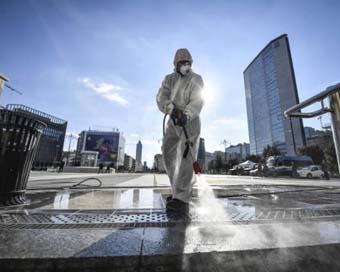Gallery
 PM Modi visit USA
PM Modi visit USA Only the mirror in my washroom and phone gallery see the crazy me : Sara Khan
Only the mirror in my washroom and phone gallery see the crazy me : Sara Khan Karnataka rain fury: Photos of flooded streets, uprooted trees
Karnataka rain fury: Photos of flooded streets, uprooted trees Cannes 2022: Deepika Padukone stuns at the French Riviera in Sabyasachi outfit
Cannes 2022: Deepika Padukone stuns at the French Riviera in Sabyasachi outfit Ranbir Kapoor And Alia Bhatt's Wedding Pics - Sealed With A Kiss
Ranbir Kapoor And Alia Bhatt's Wedding Pics - Sealed With A Kiss Oscars 2022: Every Academy Award Winner
Oscars 2022: Every Academy Award Winner Shane Warne (1969-2022): Australian cricket legend's life in pictures
Shane Warne (1969-2022): Australian cricket legend's life in pictures Photos: What Russia's invasion of Ukraine looks like on the ground
Photos: What Russia's invasion of Ukraine looks like on the ground Lata Mangeshkar (1929-2022): A pictorial tribute to the 'Nightingale of India'
Lata Mangeshkar (1929-2022): A pictorial tribute to the 'Nightingale of India' PM Modi unveils 216-feet tall Statue of Equality in Hyderabad (PHOTOS)
PM Modi unveils 216-feet tall Statue of Equality in Hyderabad (PHOTOS)The Badminton Association of India (BAI) has announced a 14-member-strong India squad for
- Men’s Sr Hockey Nationals to be played in division-based format from April 4
- Mensik denies Djokovic 100th title in Miami final
- KIPG: Son of a vegetable vendor, Bihar’s Jhandu Kumar eyes Worlds, 2028 Paralympics
- Hardik Singh credits hard work and team unity for receiving HI Midfielder of the Year award
- Djokovic, Alcaraz land in same half of Miami draw
Novel coronavirus stable for hours on surfaces: Study Last Updated : 18 Mar 2020 12:38:35 PM IST 
file photo The virus responsible for COVID-19 disease, which has claimed over 7,000 lives globally, can be kept stable for several hours to days in aerosols and on surfaces, according to a new study.
The researchers at the US National Institutes of Health (NIH), found that severe acute respiratory syndrome coronavirus 2 (SARS-CoV-2) was detectable in aerosols for up to three hours, up to four hours on copper, up to 24 hours on cardboard and up to two to three days on plastic and stainless steel.The findings, published in the new England Journal of Medicine, provide key information about the stability of SARS-CoV-2, which causes COVID-19 disease, and suggests that people may acquire the virus through the air and after touching contaminated objects.According to the researchers, the study information was widely shared during the past two weeks after the researchers placed the contents on a preprint server to quickly share their data with colleagues.The NIH scientists, from the National Institute of Allergy and Infectious Diseases' Montana facility at Rocky Mountain Laboratories, compared how environment affects SARS-CoV-2 and SARS-CoV-1, the virus that causes SARS.SARS-CoV-1 was eradicated by intensive contact tracing and case isolation measures, and no cases have been detected since 2004. SARS-CoV-1 is the human coronavirus most closely related to SARS-CoV-2, according to the study.In the stability study the two viruses behaved similarly, which unfortunately fails to explain why COVID-19 has become a much larger outbreak.The research attempted to mimic virus being deposited from an infected person onto everyday surfaces in a household or hospital setting, such as through coughing or touching objects. The scientists then investigated how long the virus remained infectious on these surfaces.The findings affirm the guidance from public health professionals to use precautions similar to those for influenza and other respiratory viruses to prevent the spread of SARS-CoV-2, including avoiding close contact with people who are sick; avoiding touching eyes, nose, and mouth; staying home when people are sick; covering cough or sneeze with a tissue; and cleaning and disinfecting frequently touched objects and surfaces.The study was jointly carried out by scientists from the NIH, as well as the Centers for Disease Control and Prevention, the University of California, Los Angeles, and Princeton University.IANS New York For Latest Updates Please-
Join us on
Follow us on








172.31.16.186







